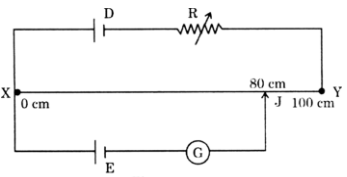 Short Answer Type
Short Answer Type(i) What is meant by:
(1) Drift velocity and
(2) Relaxation time?
(ii) A metallic plug AB is carrying a current I (see Figure 4 below). State how the drift velocity of free electrons varies, if at all, from end A to end B.
i)
1. Drift velocity - The average velocity acquired by electrons in a conductors subjected to an electric field is called drift velocity.
2. Relaxation time - The average distance travelled by a free electron between two successive collisions is called mean free path (λ). The average time interval between two successive collisions is called the relaxation time. It is denoted by τ.
(ii) Drift velocity of free electrones: Current flow in a metallic conductor is due to the valence electrons in it. The valence electrons are not attached to any particular atom. They are free to move about within the metal, just like the molecules of a perfect gas. These electrons are called conduction electrons. Suppose the metallic conductor is not connected to any external source of e.m.f., say a cell. Then there is no electric field. The electrons move at random, collide with other electrons and the ion core. But radius of an electron is very small (about 10-13 cm) compared with the radius of the atom. So the collision between a conduction electron and other electrons is neglected. Like the gas molecules the conduction electrons move in all directions with all possible velocities.
Let the velocities of the electrons at any instant be u1 , u2, .... un .
Then the average velocity of the electrons at any instant is,  ,
,
where N is the total number of electrons.
The motion of the electrons called thermal motion which depends on temperature.
Since the average velocity at any instant is zero, there is no net transport of electric charge in any direction.
Hence there is no electric current.
This random velocity of the electrons is called thermal velocity. At room temperature the thermal velocity is about 106 ms-1 . 
When an external electric field is applied to the metallic conductor the electrons are accelerated in a direction opposite to that of the field.
The electrons get accelerated and gain kinetic energy. They collide with atoms (ions) of the metal.
During collision electrons give their energy to the atoms. Hence their velocities decrease. But again they are accelerated.
There is collision once again and the increased velocity thus is reduced. Due to repeated collisions the average acceleration of the electrons is reduced to zero.
The electrons acquire a constant average velocity opposite to the direction of the electric field. This velocity is called the drift velocity.
Let us find an expression for drift velocity. Under the action of the applied electric field the velocity of the electron becomes
v1 = u1 + a ![]()
where, ![]()

(i) State any two differences between a moving coil galvanometer and a tangent galvanometer.
(ii) What is the use of a Cyclotron?
When an alternating emf e = 300 Sin (100 πt + π/6) Volt is applied to a circuit, the current I through it is I = 5.0 Sin (100 πt - π/6) ampere. Find the :
(i) Phase difference between the emf and the current.
(ii) Average power consumed by the circuit.
In which part of the electromagnetic spectrum, do the following radiations lie:
(i) Having wavelength of 20 nm
(ii) Having frequency of 10 MHz
